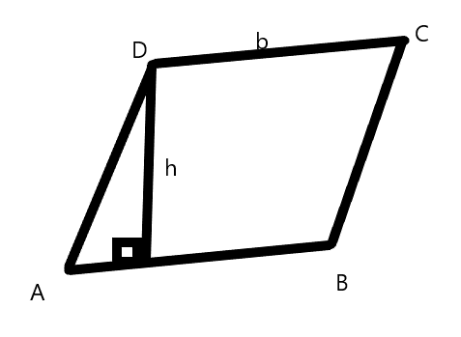
If base of parallelogram is twice it’s height. If the area of parallelogram is \[{\text{72sq}}{\text{.cm}}\].Find its height ?
Answer
577.2k+ views
Hint: We use the given relation of base and height of parallelogram and use the formula to calculate the area of parallelogram as \[{\text{A = b}}{\text{.h}}\]. So , our required solution will be obtained.
Complete step by step answer:
As per given base of a parallelogram is twice its height,
Diagram

So let the height of the parallelogram be x.
And so the base will be 2x.
Now put the above values in formula of area ,
As \[{\text{A = b}}{\text{.h}}\]
\[
{\text{A = 2x}}{\text{.x}} \\
\Rightarrow {\text{72 = 2}}{{\text{x}}^{\text{2}}} \\
\Rightarrow {{\text{x}}^{\text{2}}}{\text{ = 36}} \\
{\text{On taking square root, we get,}} \\
{\text{x = 6cm}} \\
\]
On substituting the value of x, we get base as \[{\text{2 $\times$ 6 = 12cm}}\] and height as \[{\text{6cm}}\]
Hence , the length of base and height are \[{\text{12cm,6cm}}\].
Note: A parallelogram is a quadrilateral with opposite sides parallel (and therefore opposite angles equal). A quadrilateral with equal sides is called a rhombus, and a parallelogram whose angles are all right angles is called a rectangle.
There are six important properties of parallelograms to know:
1) Opposite sides are congruent (AB = DC).
2) Opposite angles are congruent (D = B).
3) Consecutive angles are supplementary (A + D = 180°).
4) If one angle is right, then all angles are right.
5) The diagonals of a parallelogram bisect each other.
6) Each diagonal of a parallelogram separates it into two congruent triangles.
Complete step by step answer:
As per given base of a parallelogram is twice its height,
Diagram

So let the height of the parallelogram be x.
And so the base will be 2x.
Now put the above values in formula of area ,
As \[{\text{A = b}}{\text{.h}}\]
\[
{\text{A = 2x}}{\text{.x}} \\
\Rightarrow {\text{72 = 2}}{{\text{x}}^{\text{2}}} \\
\Rightarrow {{\text{x}}^{\text{2}}}{\text{ = 36}} \\
{\text{On taking square root, we get,}} \\
{\text{x = 6cm}} \\
\]
On substituting the value of x, we get base as \[{\text{2 $\times$ 6 = 12cm}}\] and height as \[{\text{6cm}}\]
Hence , the length of base and height are \[{\text{12cm,6cm}}\].
Note: A parallelogram is a quadrilateral with opposite sides parallel (and therefore opposite angles equal). A quadrilateral with equal sides is called a rhombus, and a parallelogram whose angles are all right angles is called a rectangle.
There are six important properties of parallelograms to know:
1) Opposite sides are congruent (AB = DC).
2) Opposite angles are congruent (D = B).
3) Consecutive angles are supplementary (A + D = 180°).
4) If one angle is right, then all angles are right.
5) The diagonals of a parallelogram bisect each other.
6) Each diagonal of a parallelogram separates it into two congruent triangles.
Recently Updated Pages
Master Class 9 Social Science: Engaging Questions & Answers for Success

Master Class 9 Science: Engaging Questions & Answers for Success

Master Class 9 English: Engaging Questions & Answers for Success

Master Class 9 Maths: Engaging Questions & Answers for Success

Master Class 9 General Knowledge: Engaging Questions & Answers for Success

Class 9 Question and Answer - Your Ultimate Solutions Guide

Trending doubts
Which places in India experience sunrise first and class 9 social science CBSE

Fill the blanks with the suitable prepositions 1 The class 9 english CBSE

Write the 6 fundamental rights of India and explain in detail

Difference Between Plant Cell and Animal Cell

What is pollution? How many types of pollution? Define it

What is the Full Form of ISI and RAW




